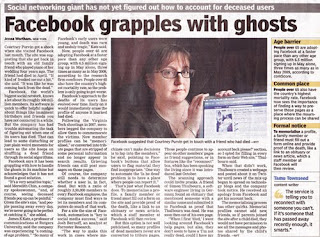NEW YORK
Courtney Purvin got a shock when she visited Facebook last month. the site was suggestion that she get back in touch with an old family friend who played piano at her wedding four years ago. The friend had died in April. "It kind of freaked me out a bit," she said. "It was like he was coming back from the dead."
Facebook, the world's biggest social network, knows a lot about its roughly 500 million members. Its software is quick to offer helpful nudges about things like imminent birthdays and friends you have not contacted in a while. But the company has had trouble automating the task of figuring out when one of its users has died. That can lead to some disturbing or just plain weird moments for users as the site keeps on shuffling a dead friend through its social algorithms.
Facebook says it has been grappling with how to handle the ghosts in its machine but acknowledges that it has not found a good solution.
'It's a very sensitive topic," said Meredith Chin, a company spokeswoman, "and, of course, seeing deceased friends pop up can be painful." given the site's size," and people passing away every day, we're never going to be perfect at catching it," she added.
James E Katz, a professor of communications at Rutgers University, said the company was experiencing "a coming-of-age problem." "So many of Facebook's early users were young, and death was rare and unduly tragic,' Katz said.
Now, people over 65 are adopting Facebook at a faster pace than any other age group, with 6.5 million signing up in May alone, three times as many as in May 2009, according to the research firm comScore. People over 65 also have the country's highest mortality rate, so the problem is only going to get worse.
Facebook's approach to the deaths of its users has evolved over time. early on it would immediately erase the profile of anyone it learned had died.
Following the Virginia Tech shooting in 2007, members begged the company to allow them to commemorate the victims. Now member profiles can be "memorialised," or converted into tribute pages that are stripped of some personal information and no longer appear in search results. Grieving friends can still post messages on those pages.
Of course, the company still needs to determine whether a user is, in fact, dead. But with a ratio of roughly 3,50,000 members to every Facebook employee, the company must find ways to let its members and its computers do much of that work.
For a site the size of Facebook, automation is 'key to social media success," said Josh Bernoff, no analyst at Forrester Research.
"The way to make this work in cases where ,machines can't make decisions is to tap into the members," he said, pointing to Facebook's buttons that allow users to flag material they find inappropriate. "One way to automate the 'Is he dead' problem is to have a place where people can report it."
That's just what Facebook does. to memorialise a profile, a family member or friend must fill out a form on the site and provide proof of the death, like a link to an obituary or news article, which a staff member at Facebook will then review.
But this option is not well publicised, so many profiles of dead members never are converted to tribute pages. Those people continue to appear on other members' pages as friend suggestions, or in features like the "reconnect' box. which has been spooking the living since it was introduced last October.
The scanning approach could invite pranks. A friend of Simon Thulbourn, a software engineer living in Germany, found an obituary that mentioned someone with a similar name and submitted it to Facebook as proof that Thulbourn was dead. he was soon then out of his own page.
"When I first 'died,' I went looking around Facebook's help pages, but alas, they don't seem to have alas, they don't seem to have a 'I'm not really dead. could I have my account back please?' section, so I opted for filling in every form on their Web site," Thulbourn said.
When that didn't work, Thulbourn created a webpage and posted about it on Twitter until news of the mix-up began to spread on technology blogs and the company took notice. He received an apology from Facebook and got his account back.
The memorialising process has other quirks. Memorial profiles cannot add new friends, so if parents joined the site after a child died, they would not have permission to see all the messages and photos shared by the child's friends.
Age barrier
People over 65 are adopting Facebook at a faster pace than any other age group, with 6.5 million signing up in May alone, three times as many as in May 2009, according to comScore.
Common place
People over 65 also have the country's highest mortality rate. Facebook now sees the importance of finding a way to preserve those pages as a place where the mourning process can be shared
Formal notice
To memorialise a profile, a family member or friend must fill out a form online and provide proof of the death, like a link to an obituary or news article, which a staff member at Facebook will them review.
Tamu Townsend
-content writer
"The service is telling you to reconnect with someone you can't. If it's someone that has passed away recently enough, it smarts."


No comments:
Post a Comment